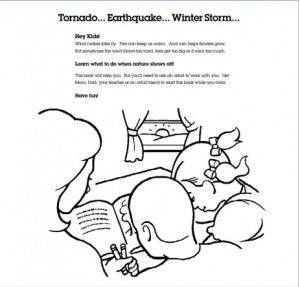

2. After going through the coloring page, tell your child that they need their special backpack when there’s an emergency.
3. Have a pile of items (maybe 2-3 for now, you can put more in the next time you play) to put into the emergency kit. Pull one item out at a time. Ask the child to identify or guess what the item is and what they would use the item for. If they don’t know, help them. Let them put it in the backpack. CAUTION: Many of the items will be similar to what they already use daily so it’s important to specify that these are special pull-ups or a special sippy cup that they only use when an adult tells them to get the emergency backpack. Repeat this point and ask/tell them the appropriate time to use each item. 4. Talk with your child about things they’d want to have in an emergency to help them feel happy. You’ll want to include some of their favorite snacks and a blanket or toy in the emergency kit. CAUTION: You may not want to put toys or blankets your child is attached to into the bag at the moment but take note of these things so you can bring them or get duplicates to put in later. 5. After you put all the items in the backpack, explain to your child that “we need to put this backpack in a place where we can grab it quickly for an emergency.” Help your child select a place to store the bag, close to the front door. Make sure they understand to only get this special backpack out when they are told by an adult. 6. Show the toddler you have a special backpack as well, stored in the same place, or if it isn’t, go move the backpack to the same place. Show them some of the items in your kit. This is an activity that you’ll want to do often. You can do it when it’s time to replace items or you can do it once every three months, reiterating the same ideas and principles about preparedness. Review the items that are already in the bag, put them back in, and add other things as needed. Check out the Insight Article, “Special Considerations for Emergency Kits” to help you decide what to include in your toddler’s kit. And while you’re at it, check out our other articles about prepping for kids and teens: “Prepare Teens for Real-Life Disasters Using Young Adult Fiction” “Survival Skills for Kids: Outdoor Survival Games” Have you tried to teach your toddler about preparedness? What did you do? What suggestions do you have for other parents or caregivers? Let us know in the comments.
1 comment
Dave D
Great ideas! Thanks for the post.